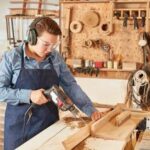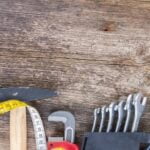Woodworking has experienced a surge in popularity as both a hobby and a profession in recent years. However, the high cost of new woodworking equipment can pose a significant barrier for beginners or those on a limited budget. That’s where buying used woodworking equipment becomes an attractive option. In this article, we will explore why purchasing used woodworking equipment can be a smart choice for woodworkers of all levels.
The expense associated with new woodworking equipment is often prohibitive for those just starting out or pursuing woodworking as a hobby. Quality tools can come with a hefty price tag, making it difficult for beginners to invest in the necessary equipment. However, by opting to buy used tools, woodworkers can not only save significant amounts of money but also gain access to high-quality brands and models that may have been otherwise out of their budget range.
Additionally, buying used woodworking equipment provides the opportunity to discover vintage or rare pieces that may no longer be available as new. These collectible items not only possess unique qualities but can also add character and charm to one’s workshop. Furthermore, purchasing pre-owned equipment allows individuals to tap into the knowledge and experience of previous owners who may have customized or modified the tools for improved performance.
Advantages of buying used woodworking equipment
When it comes to woodworking, investing in equipment can quickly become expensive. However, buying used woodworking equipment can be a smart choice for both beginners and experienced woodworkers. There are several advantages to purchasing used equipment that make it a viable alternative to buying new.
One of the primary advantages of buying used woodworking equipment is the cost savings. New woodworking equipment can be quite pricey, especially for those who are just starting out or pursuing woodworking as a hobby. By opting for used equipment, woodworkers can save a significant amount of money while still acquiring the tools they need.
Another advantage of buying used is the opportunity to access a wider range of high-quality brands and models within one’s budget. Woodworking enthusiasts often have their eyes on top-of-the-line brands that may be out of reach when purchasing new. However, by considering used options, woodworkers have the chance to find these high-quality brands at more affordable prices.
Moreover, there is also the potential to stumble upon vintage or rare pieces of woodworking equipment that may no longer be available as new. These unique finds not only add character and charm to a woodworker’s collection but can also offer durability and craftsmanship that stand the test of time.
To ensure a successful purchase when buying used woodworking equipment, there are several factors to consider. Thoroughly inspecting the equipment for any damages or flaws is vital in order to avoid making a poor investment. Checking for signs of wear and tear on key components like motors, blades, fences, and tables should be part of this inspection process.
Additionally, researching the reputation and performance history of the brand or model is crucial. This step will help prospective buyers make an informed decision about whether the pre-owned item is still in good working condition and if it aligns with their specific needs.
Overall, purchasing used woodworking equipment has numerous advantages such as cost savings, access to high-quality brands/models within budget limitations, and finding unique vintage pieces that may no longer be available as new. However, there are also risks and challenges that buyers must consider, such as hidden defects or missing parts. By thoroughly researching and inspecting potential purchases, woodworkers can mitigate these risks and make a wise investment in their woodworking journey.
Factors to consider when buying used woodworking equipment
When purchasing used woodworking equipment, there are several important factors to consider that can help ensure a successful and beneficial purchase.
- Thoroughly inspect the equipment: Before committing to buying used woodworking equipment, it is crucial to thoroughly inspect it for any damages or flaws. This includes examining the overall condition of the equipment, checking for rust, cracks, or signs of wear and tear. Inspecting key components such as motors, blades, fences, and tables will help determine if they are in good working condition.
- Research the brand/model’s reputation and performance: It is important to research the reputation and performance history of the specific brand/model you are interested in buying. Look for reviews online from other woodworkers who have used that particular equipment. This will provide insights into its durability, reliability, and overall performance.
- Determine if the equipment is still in good working condition: Along with inspecting the physical condition of the woodworking equipment, it is essential to assess whether it is still in good working condition. Test out functions such as adjusting the speed or height settings as well as any safety features. If possible, bring along some wood samples to test how well the equipment cuts or shapes them.
By considering these factors when buying used woodworking equipment, you can make a more informed decision and reduce any potential risks or disappointments associated with your purchase. Taking the time to thoroughly inspect and research each piece of equipment will increase your chances of finding a reliable tool that meets your woodworking needs without breaking your budget.
Additional resources
- Woodworking forums: Participating in online forums dedicated to woodworking can provide valuable advice and recommendations from experienced woodworkers.
- Woodworking magazines: Subscribing to reputable magazines devoted to woodworking can offer expert reviews and insights on different brands/models of woodworking equipment.
- Local woodworking shops: Visiting local woodworking shops and talking to the experts can yield valuable guidance on buying used woodworking equipment and navigating the market.
- Woodworking associations: Joining woodworking associations or clubs can not only provide access to communities of experienced woodworkers but may also include opportunities for buying or trading used equipment.
Taking advantage of these additional resources will help you gather information from knowledgeable sources and make more informed decisions when it comes to purchasing used woodworking equipment.
Tips for finding reliable sources to purchase used woodworking equipment
Online platforms and marketplaces
When searching for reliable sources to purchase used woodworking equipment, online platforms and marketplaces can be a great starting point. Websites such as eBay, Craigslist, and Facebook Marketplace often have listings from individuals selling their used equipment. These platforms usually have features that allow buyers to view the seller’s reputation or reviews from previous buyers, giving you some level of confidence in the transaction.
It is important to thoroughly read through each listing and review the seller’s return policy before making a purchase. Remember to ask questions about the item’s condition and history to ensure it meets your needs.
Local woodworking forums, trade shows, or auctions
In addition to online platforms, local woodworking forums or trade shows can also be valuable sources for finding reliable sellers of used woodworking equipment. These gatherings are often attended by knowledgeable woodworkers who may have tools or equipment they no longer require. Attending these events provides an opportunity to inspect the equipment in person and ask questions directly to the seller.
Additionally, woodworking auctions can provide access to a wide selection of used equipment under one roof. Auctions can be a treasure trove of vintage or rare pieces that might not be available elsewhere.
Negotiating with sellers
When dealing with sellers on any platform, whether online or offline, negotiating is an essential skill that can help you secure a fair price for the used woodworking equipment you desire. Start by researching and comparing prices for similar items in order to determine a reasonable range for negotiation.
During negotiations, do not hesitate to point out any flaws or damages you have discovered during your inspection as this could potentially lead to a lower price. Additionally, if possible, try offering cash payment instead of credit card transactions as this might give you more leverage for negotiating a better deal.
By following these tips in finding reliable sources for purchasing used woodworking equipment, you can increase your chances of finding quality tools at a reasonable price. Remember to thoroughly research the seller or platform before making a purchase and always inspect the equipment to ensure it meets your needs. With some patience and diligence, buying used woodworking equipment can be a smart choice for both beginners on a budget and experienced woodworkers looking to expand their tool collection.
Assessing the value and condition of used woodworking equipment
Evaluating the overall value
When purchasing used woodworking equipment, it is essential to assess its overall value. Several factors should be taken into consideration. First, consider the age of the equipment. Older equipment may have a certain charm and appeal, but it may also come with more wear and tear or outdated features. Additionally, take into account the condition of the equipment. Look for any signs of damage or excessive wear that might affect its performance.
Another crucial aspect to evaluate is the included accessories. Some used woodworking equipment may come with additional accessories or attachments that can significantly enhance its functionality. Assess whether these extras are included and whether they are in good condition.
Lastly, research the market value of similar equipment to ensure you are getting a fair deal. Take into account factors such as brand reputation, model rarity, and overall demand in determining a reasonable price range.
Inspecting key components
To ensure that a used piece of woodworking equipment is worth purchasing, it is important to inspect key components thoroughly. One of the critical elements to examine is the motor. Check if it starts smoothly and runs without any unusual noises or vibrations.
Inspecting blades is equally significant, as they directly affect the quality of your woodwork. Look for any signs of damage or dullness in the blades and determine whether they need immediate replacement or maintenance.
The fence system plays an important role in ensuring precision cuts and accurate measurements when using woodworking equipment. Take your time to inspect it carefully for any misalignments, damages, or signs of excessive wear.
Additionally, examine the condition of tables and working surfaces for flatness and cleanliness. A level surface ensures stability while working with wood, while cleanliness helps prevent debris from interfering with your projects.
Testing before purchase
Before finalizing a purchase on used woodworking equipment, it is highly recommended to test it out firsthand whenever possible. This allows you to evaluate its performance and identify any potential issues.
During the testing phase, pay attention to factors such as noise levels, vibrations, accuracy, and ease of use. Try performing various woodworking tasks with the equipment to assess its versatility and suitability for your projects.
Performing a test run also gives you an opportunity to verify that all safety features are in proper working order. Ensure that emergency stop buttons, guards, and other safety mechanisms are functional as they are crucial for ensuring your well-being while using the equipment.
By conducting a thorough evaluation of value, inspecting key components, and testing the equipment before purchase, you can make a more informed decision regarding the condition and suitability of used woodworking equipment. Taking these steps reduces the risk of investing in subpar tools and increases your chances of finding quality equipment at an affordable price.
Potential risks and challenges of buying used woodworking equipment
Buying used woodworking equipment can be a great way to save money and acquire high-quality tools. However, it is important to be aware of the potential risks and challenges that may come with purchasing used equipment. By understanding these risks and taking necessary precautions, woodworkers can minimize any potential setbacks.
One common challenge when buying used woodworking equipment is the possibility of hidden defects or missing parts. Unlike new equipment, used machinery may have undergone previous repairs or modifications that are not immediately apparent. It is crucial for buyers to thoroughly inspect the equipment before making a purchase. This includes checking for any damages or signs of wear and tear, as well as ensuring that all essential components are present.
Another challenge is the possibility of needing repairs or additional investments to bring the equipment up to optimal working condition. Used woodworking tools may require maintenance or adjustments due to their age or previous usage. Buyers should factor in any potential repair costs when considering the overall value of a used piece of equipment.
To minimize risks when buying used woodworking equipment, it is essential to thoroughly research and inspect potential purchases. Before finalizing a sale, buyers should gather information about the brand/model’s reputation and performance history. Online reviews, forums, and woodworking communities can provide valuable insights from experienced users.
Overall, while there are risks associated with buying used woodworking equipment, they can often be mitigated through careful inspection and research. By being informed and diligent during the purchasing process, woodworkers can still find great deals on high-quality tools that will serve them well in their craft.
| Risks | Challenges |
|---|---|
| Potential hidden defects | Possible need for repairs |
| Missing parts | Additional investments required |
| Incomplete equipment history | Potential lack of warranty |
Testimonials and success stories from those who bought used woodworking equipment
One of the most compelling reasons to consider buying used woodworking equipment is the success stories and positive experiences shared by those who have gone down this route. Many beginner and professional woodworkers alike have found great value and satisfaction in purchasing used equipment. These testimonials offer firsthand evidence of the benefits that can be derived from opting for pre-owned tools.
For beginners, cost savings is often a key factor in their decision to buy used woodworking equipment. The high prices of new equipment can be intimidating for those just starting out or pursuing woodworking as a hobby. However, by investing in used tools, beginners can build up their workshop at a fraction of the cost. They can take advantage of the affordability offered by pre-owned equipment to acquire essential tools without breaking the bank.
Beyond cost savings, there are also success stories that highlight the ability to acquire high-end equipment at an affordable price. Woodworkers who have been able to purchase top-of-the-line brands and models through the used market often rave about how this has elevated their craftsmanship and overall woodworking experience. By finding these exceptional deals on quality equipment, they have been able to take their skills and projects to new heights.
| Testimonial |
|---|
| “I started my woodworking journey with a limited budget, so buying new equipment was out of reach for me. I scoured online marketplaces and local auctions for used tools, and I ended up finding a fantastic deal on a high-quality table saw. It’s been reliable and has allowed me to create intricate cuts with precision. Buying used was definitely the right choice for me.” |
| “As a professional woodworker, I’m always on the lookout for great deals on equipment. I found a used planer that was in excellent condition and came from a reputable brand. Not only did I save money, but the performance of this pre-owned tool surpassed my expectations. It’s a testament to the durability and craftsmanship of older models.” |
| “I was hesitant about buying used woodworking equipment, but after hearing about others’ positive experiences, I decided to give it a try. I ended up finding a vintage bandsaw that is no longer produced. It needed some minor repairs, but the seller gave me a fair price considering its rarity. Now it’s the centerpiece of my workshop, and I cherish its history while using it to create beautiful pieces.” |
These testimonials resonate with others who may be considering purchasing used woodworking equipment, as they provide relatable stories of success and value. They showcase the potential benefits that await those who choose to explore the option of buying pre-owned tools.
Conclusion
In conclusion, buying used woodworking equipment can be a smart choice for both beginners and experienced woodworkers alike. As highlighted throughout this article, there are several advantages to purchasing used equipment, including the cost savings and the opportunity to own high-quality brands/models that may otherwise be out of reach. Additionally, finding vintage or rare pieces adds a unique element to one’s woodworking collection.
However, it is crucial to consider several factors before making a purchase. Thoroughly inspecting the equipment for any damages or flaws is essential to ensure its proper functioning. Researching the reputation and performance history of the brand/model can provide valuable insights into its reliability. Lastly, testing the equipment before finalizing the purchase will give buyers peace of mind that they are getting a good deal.
To find reliable sources for used woodworking equipment, consider online platforms or marketplaces known for reputable sellers. Visiting local woodworking forums, trade shows, or auctions can also yield great finds. When dealing with sellers, it’s essential to negotiate for a fair price and thoroughly evaluate the condition and value of the equipment based on factors such as age and included accessories.
While there may be potential risks and challenges associated with buying used woodworking equipment, many woodworkers have shared testimonials and success stories about their positive experiences with purchasing secondhand tools. By taking appropriate precautions such as thoroughly researching potential purchases and conducting thorough inspections, these risks can be minimized.
Ultimately, making an informed decision is key when buying used woodworking equipment. Consider your individual needs and circumstances while weighing the advantages and considerations discussed in this article. With careful evaluation and research, buyers can save money while potentially acquiring top-notch tools that will enhance their woodworking expertise for years to come.
Frequently Asked Questions
Where is the best place to buy used tools online?
The best place to buy used tools online can vary depending on personal preferences and needs. However, one popular option is eBay. eBay offers a wide range of used tools from different sellers, allowing you to compare prices and conditions.
Additionally, eBay has a feedback system that provides insight into the reputation and reliability of sellers, helping you make more informed decisions. Another notable online marketplace for used tools is Craigslist, where you can find local sellers within your area and potentially negotiate prices or inspect items in person before purchasing.
What should you avoid when working with woodworking machines?
When working with woodworking machines, it is essential to avoid complacency and neglecting safety precautions. One should never engage in careless practices such as removing guards or safety devices for convenience or expediency’s sake. It is crucial to have a thorough understanding of each machine’s operating manual and follow all safety recommendations diligently.
Ignoring safety measures can lead to serious injuries or accidents. Additionally, avoiding distractions while operating woodworking machines is vital for maintaining focus and concentration on the task at hand.
Who makes the best woodworking tools?
Determining the best woodworking tool manufacturer depends on various factors such as specific needs, quality requirements, and budget constraints. Several reputable brands are known for producing high-quality woodworking tools consistently. Some well-regarded names in this field include Bosch, DEWALT, Festool, Makita, and Milwaukee Tools.
These manufacturers have garnered positive reputations due to their commitment to craftsmanship, innovation in design, durability of their products, and extensive range of offerings suitable for both professionals and hobbyists alike. Ultimately, it is advisable to research specific tools within each brand’s lineup to determine which manufacturer aligns best with one’s unique requirements.

Hi everyone! I’m a woodworker and blogger, and this is my woodworking blog. In my blog, I share tips and tricks for woodworkers of all skill levels, as well as project ideas that you can try yourself.





